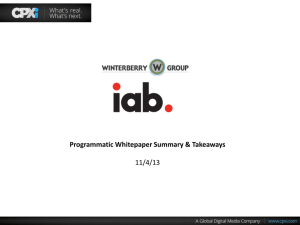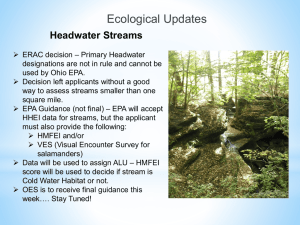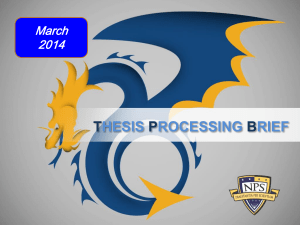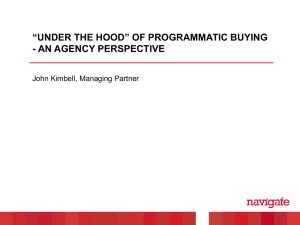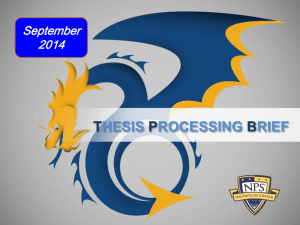Section 6(f) - Ohio Department of Transportation
advertisement
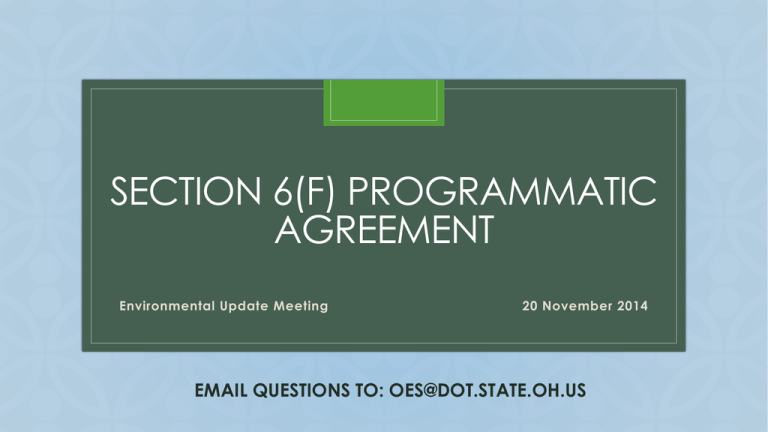
SECTION 6(F) PROGRAMMATIC AGREEMENT C Environmental Update Meeting 20 November 2014 EMAIL QUESTIONS TO: OES@DOT.STATE.OH.US Section 6(f) Primer The federal LWCF Act (Public Law 88-578) was passed by Congress on September 3, 1964 and became effective January 1, 1965. Section 6(f) of the LWCF Act applies to the conversion of certain recreation lands to non-recreational purposes and is applicable to all recreation lands that have received LWCF financial assistance Section 6(f) applies to all public properties that have received Land and Water Conservation Funds (LWCF) Section 6(f) Programmatic Agreement Between ODOT, FHWA, ODNR, and NPS Approved April 2014 Streamlines review and approval process Created a standardized form that replaced the NPS Environmental Screening Form Review and approval of submittals is now 30 calendar days per agency Section 6(f) Programmatic Agreement Maintenance type projects Definition: Reconstruct, repair, replace outdoor recreational feature or support a feature Staging and construction in place for less than 6 months O Section 6(f) Programmatic Agreement Maintenance type projects Approval process: District confirm with ODOT-OES that project meets Maintenance type project criteria Section 6(f) Programmatic Agreement Temporary Non-Conforming Use Definition: Temporary non-recreation use lasting less than 6 months OES will submit completed Section 4(f)/6(f) form to ODNR for approval Section 6(f) Programmatic Agreement Temporary Non-Conforming Use Approval Process: Districts confirm with OES and ODNR Temporary Non- Conforming Use is appropriate District submits Section 4(f)/6(f) form to OES OES coordinates form with ODNR ODNR reviews and provides approval or comments within 30 days copying NPS on response Section 6(f) Programmatic Agreement Conversions Definition: Permanent incorporation of Section 6(f) property into transportation facility Temporary incorporation lasting longer than 6 months Section 6(f) Programmatic Agreement Conversions Approval Process: Districts confirm with OES, ODNR, NPS that a conversion is required Identification of replacement property part of consultation Districts submit Section 4(f)/6(f) form including replacement property information to OES Section 6(f) Programmatic Agreement Conversions Approval Process (cont.): OES will coordinate form with ODNR ODNR will review and submit to NPS NPS will review and provide approval and/or comments to ODNR and copy ODOT Section 6(f) Programmatic Agreement What does NPS approval of consultation mean? Consultation with ODOT-OES, ODNR and NPS is required prior to approval of the NEPA document. The NPS concurrence will form the basis for the FHWA NEPA decision regarding the Section 6(f) property. ODOT will document any project level requirements as environmental commitments. This includes completing conversions and other mitigative requirements. Section 6(f) Programmatic Agreement The conversion process including the appraisal and acquisition of the replacement property may be done as an environmental commitment so long as it is completed prior to final acceptance of the construction project by the engineer. This includes all activities beyond the identification and concurrence of the use of a potential replacement property under Section F of this Agreement. Section 6(f) Programmatic Agreement Real Estate Process for Conversions The PA allows for ODOT to follow the FHWA appraisal process in lieu of the NPS UASFLA “Yellow Book” Standard. Appraisals will follow the Uniform Act and 49 CFR Part 24 and the Uniform Standards of Professional Appraisal Practice (USPAP) for projects in Ohio Section 6(f) Programmatic Agreement Real Estate Process for Conversions ODOT has developed a procedure for the real estate process. It is called: VALUATION PROCEDURES FOR 6(f) CONVERSIONS AND REPLACEMENTS It is maintained jointly by ODOT’s Office of Environmental Services and Office of Right-of-Way Section 6(f) Programmatic Agreement Real Estate Process for Conversions ODOT shall continue to coordinate with ODNR and NPS through the Conversion Process until it is complete ODOT will document the results of the conversion. The construction project will not be closed until the engineer is satisfied any commitments are met.

